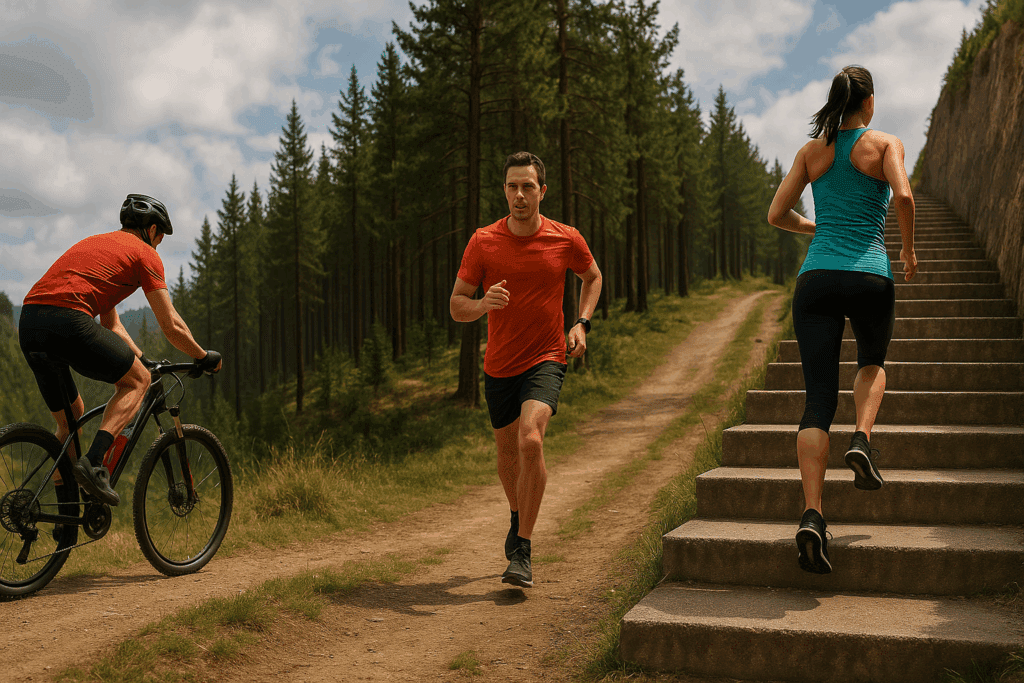In a world that celebrates energy, performance, and productivity, the concepts of stamina and endurance have taken center stage. Whether you’re a seasoned athlete, a weekend warrior, or someone simply looking to keep up with the demands of a fast-paced lifestyle, understanding how to increase stamina and endurance naturally is essential. These two attributes not only determine how long you can sustain physical activity, but they also significantly affect mental alertness, emotional resilience, and long-term health outcomes. And perhaps most importantly, they are intricately tied to cardiovascular endurance, which serves as a foundation for a healthy, active body. As individuals strive to enhance their quality of life, learning how to build endurance and improve stamina becomes an integral part of a holistic wellness strategy.
You may also like: How to Stop Emotional Eating and Regain Control: Mindful Nutrition Strategies That Support a Healthier Lifestyle
True stamina and endurance aren’t built overnight, but the rewards of a well-informed approach are manifold. From enhanced performance in daily activities to reduced fatigue and a stronger heart, building stamina and endurance requires a strategic blend of movement, nutrition, recovery, and consistency. In the sections that follow, we’ll explore effective, evidence-based strategies—rooted in physiology and nutritional science—that can help anyone looking to discover the best way to build endurance and support cardiovascular fitness. This guide delves into stamina training protocols, dietary choices that power endurance, and the subtle yet critical lifestyle shifts that can lead to sustainable energy. More importantly, the content adheres to the principles of EEAT—Experience, Expertise, Authoritativeness, and Trustworthiness—to ensure the information is reliable, well-researched, and actionable.

Understanding the Foundations of Stamina and Endurance
At the heart of stamina and endurance lies the body’s ability to sustain effort over time. While the terms are often used interchangeably, there is a subtle distinction worth noting. Stamina typically refers to the capacity to perform activities for extended periods without excessive fatigue. Endurance, on the other hand, is the body’s ability to resist fatigue and recover efficiently after exertion. In the context of fitness and health, building stamina and endurance means training both the muscular and cardiovascular systems to support prolonged activity with greater ease.
Cardiovascular endurance plays a pivotal role in this equation. It represents how effectively the heart, lungs, and circulatory system deliver oxygen to working muscles during sustained physical activity. The stronger the cardiovascular system, the more efficiently oxygen is transported, allowing for improved stamina and performance. When individuals participate in activities to improve cardiovascular fitness, they also benefit from lowered blood pressure, reduced cholesterol levels, and enhanced metabolic function.
The physiological benefits of endurance go far beyond exercise. High stamina levels are linked to better immune function, increased cognitive performance, and enhanced mood stability due to improved oxygenation and hormonal balance. Meanwhile, good endurance allows for better energy utilization, meaning the body can burn fats and carbohydrates more effectively during activity. These outcomes collectively demonstrate why stamina training and cardiovascular conditioning should be viewed not just as athletic goals, but as foundational pillars of long-term health.

Stamina Training: How to Build Cardio Endurance Fast Without Risking Burnout
When it comes to how to build cardio endurance fast, the key lies in structured and progressive training. One of the most effective methods is interval training, which alternates periods of high-intensity effort with recovery periods. High-Intensity Interval Training (HIIT), for example, not only improves cardiovascular endurance but also increases lactate threshold and VO2 max—the body’s maximum oxygen uptake. This type of stamina training enables the heart and lungs to become more efficient in less time compared to steady-state cardio alone.
However, it’s important to avoid the temptation of doing too much too soon. Individuals wondering how to increase endurance must remember that adaptation occurs gradually. Overtraining can lead to fatigue, muscle breakdown, and even suppressed immune function. A progressive approach, starting with manageable durations and intensities and increasing them incrementally, is the best way to build stamina without injury. Listening to the body’s signals during recovery periods helps ensure you’re building resilience rather than risking regression.
One overlooked strategy for how to improve stamina is incorporating cross-training into your routine. By mixing running, swimming, cycling, and bodyweight circuits, you engage different muscle groups, reduce the risk of repetitive strain, and keep the workout experience mentally engaging. These varied workouts to increase stamina contribute to a well-rounded and adaptable cardiovascular system. Furthermore, regular participation in strength stamina and endurance training helps build not only aerobic capacity but also muscular resilience, which collectively improves overall endurance.

The Role of Strength and Resistance Training in Building Endurance
While most people equate endurance with aerobic exercise, strength training plays a vital supporting role in the equation. Resistance training enhances muscular efficiency, increases joint stability, and fortifies the skeletal system, all of which support the ability to perform prolonged physical activity. When designing exercises to build endurance and stamina, incorporating resistance elements—such as squats, lunges, and weighted carries—can be transformative.
Strength stamina and endurance training doesn’t just make you stronger—it helps delay the onset of muscular fatigue. As a result, you can maintain form and performance for longer durations. For those asking how can I build up my stamina or how can we increase stamina effectively, integrating compound strength movements into a weekly training schedule is essential. These movements activate multiple muscle groups, simulate real-world physical challenges, and improve neuromuscular coordination.
Additionally, resistance training increases mitochondrial density in muscle tissue. Since mitochondria are the powerhouses of the cell, more mitochondria mean better energy production and oxygen use—critical for cardiovascular endurance and stamina building exercises. By alternating between endurance-focused sessions and strength sessions, the body is continuously challenged in new ways, leading to more comprehensive and sustainable fitness gains. This integrated approach represents the best workout for stamina and endurance because it strengthens the body holistically.

Smart Cardiovascular Workouts to Increase Stamina and Endurance
Designing smart cardiovascular workouts involves more than just hopping on a treadmill. The best way to increase endurance is to target the cardiovascular system in dynamic and challenging ways. Long-duration aerobic activities like jogging, rowing, and cycling are excellent for building a strong aerobic base, while short bursts of sprinting or hill repeats serve to expand anaerobic thresholds. This combination ensures the heart is trained across a wide spectrum of intensities, preparing it for real-life physical demands.
Workouts to increase endurance should also include progressive overload, a training principle that involves gradually increasing the difficulty of an exercise to continue challenging the body. For example, if you normally jog for 20 minutes, aim to increase the duration by 10% each week. This slow and steady progression helps improve endurance without overtraining. In contrast, sudden large jumps in workload may lead to injury or burnout.
Good stamina exercises also involve real-world functionality. For instance, stair climbing, hiking with a weighted backpack, or agility drills mimic the kinds of efforts required in daily life or sports performance. These movements reinforce the neural pathways involved in balance, coordination, and force generation, which in turn contribute to more fluid and sustainable movement patterns. Those exploring how to have more stamina or how to get more stamina quickly will benefit from the real-life carryover of such exercises.
Nutrition for Endurance: Eating to Fuel Performance and Recovery
Physical training alone is not enough to improve stamina. Nutrition plays an equally critical role in how to build stamina and endurance. A diet rich in complex carbohydrates, healthy fats, lean proteins, and micronutrients supports the energy systems responsible for sustained activity. Carbohydrates are especially vital, as they serve as the body’s primary energy source during endurance exercise. Without adequate glycogen stores, fatigue sets in quickly, hampering performance.
Equally important is hydration. Even a 2% decrease in body water can lead to a significant drop in performance. Electrolyte balance is crucial for maintaining nerve conduction and muscle function. Thus, water alone may not be sufficient during extended sessions; beverages containing sodium, potassium, and magnesium can aid in better hydration. Individuals often overlook the role of micronutrients like iron, which is essential for oxygen transport, and B vitamins, which aid in energy metabolism. These nutrients directly influence how to improve endurance at a cellular level.
Post-workout recovery meals should be viewed as an opportunity to repair tissue and replenish energy stores. Combining carbohydrates with protein within an hour of training promotes muscle repair and glycogen resynthesis. For those looking into how to boost stamina and endurance sustainably, meal timing and nutrient quality matter just as much as the calorie count. Nutritional discipline, consistency, and personalization are all part of the best way to build stamina and support long-term health.

Lifestyle Strategies to Support Cardiovascular Fitness and Recovery
In the quest for how to build endurance and stamina, lifestyle choices often make or break long-term progress. Sleep, for instance, is a cornerstone of recovery. Deep sleep stages promote muscle repair, hormonal balance, and cognitive processing. Without adequate rest, even the most rigorous stamina exercises may yield suboptimal results. Aiming for 7–9 hours of high-quality sleep per night is a practical yet powerful way to support training gains.
Stress management is another key factor. Chronic stress elevates cortisol levels, which can impair recovery, reduce muscle mass, and dampen immune function. Incorporating mindfulness practices such as yoga, meditation, or even nature walks into your routine can mitigate the negative impact of stress. These strategies don’t just benefit mental health—they help build endurance by supporting the nervous system’s ability to regulate energy use efficiently.
Additionally, periodization—or strategic variation in training intensity over time—helps avoid plateaus and overuse injuries. For individuals wondering how to increase stamina and endurance sustainably, alternating between high and low-intensity sessions while including rest days can dramatically enhance performance. This concept also supports individuals who participate in activities to improve cardiovascular fitness by ensuring the body has time to adapt to and recover from stressors.

How to Stay Motivated While Building Stamina and Endurance
One of the less-discussed aspects of stamina training is the psychological component. Staying consistent with a training regimen requires motivation, especially when progress feels slow. One of the best ways to build stamina and maintain enthusiasm is to set short-term, measurable goals. These could be as simple as increasing running distance by a mile every two weeks or shaving seconds off your swim time. Having clear benchmarks helps track improvement and maintain momentum.
Another strategy is community engagement. Training with a partner or joining a group focused on endurance events fosters accountability and shared motivation. Social support provides encouragement during difficult sessions and makes the process more enjoyable. It also reduces the mental fatigue that can accompany solitary training.
Mental visualization and self-talk are powerful tools to increase stamina and endurance. By rehearsing challenging workouts in your mind and reinforcing positive beliefs about your ability, you enhance mental resilience. The brain, after all, plays a central role in how the body responds to exertion. Individuals looking into how to improve stamina and gain endurance often find these psychological strategies as vital as their physical counterparts.
Frequently Asked Questions (FAQ) on How to Increase Stamina and Endurance Naturally
What role does breathing technique play in improving stamina and endurance?
Breathing technique is often overlooked in discussions about how to increase stamina and endurance, yet it can significantly influence performance. Efficient breathing supports better oxygen delivery to working muscles, directly impacting cardiovascular endurance. Techniques like diaphragmatic breathing and rhythmic breath control help regulate heart rate and reduce the perceived exertion during stamina training. Practicing breath control in both low- and high-intensity workouts can enhance lung capacity over time, which is essential when trying to build cardio endurance fast. Whether engaging in stamina building exercises or longer endurance sessions, integrating structured breathing techniques can yield improvements that are both immediate and long-lasting.
How can mental resilience impact your ability to build stamina and endurance?
Mental resilience is a key psychological driver that often determines how to build stamina and endurance successfully. Endurance athletes frequently rely on mental training to push through physical discomfort and stay motivated. Visualization, positive self-talk, and goal-setting can all contribute to mental stamina, which in turn enhances physical performance. For individuals exploring how to gain endurance, building mental toughness through mindfulness or cognitive training may improve not only their workouts but also their recovery process. The ability to stay mentally engaged during stamina exercises is just as crucial as physical preparedness, especially when pursuing the best workout for stamina and endurance.
Can environmental factors influence cardiovascular endurance and stamina development?
Environmental variables such as altitude, temperature, and humidity can have a profound effect on how to build cardio endurance fast. Training at high altitudes, for example, reduces oxygen availability and forces the body to adapt by producing more red blood cells, thereby enhancing cardiovascular endurance over time. Heat and humidity, on the other hand, require the body to work harder to cool itself, elevating the cardiovascular demand during stamina training. These challenges can be strategically used to improve endurance in controlled ways. However, it’s important to adjust intensity and hydration protocols accordingly, especially during workouts to increase stamina under extreme conditions.
What are some early indicators that your stamina training is working?
Early signs that stamina training is yielding results include reduced resting heart rate, faster post-exercise recovery, and the ability to perform longer sessions without hitting fatigue early. As you continue with exercises to build endurance and stamina, you might also notice improved sleep quality, mental clarity, and even mood stability. One practical measure is your ability to maintain a conversation while jogging or cycling—an indicator of growing cardiovascular endurance. Another is your capacity to increase workout volume without feeling sore or depleted for days afterward. If you’re wondering how to improve stamina with tangible feedback, tracking heart rate variability and perceived exertion over time offers meaningful insight.
How can we increase stamina safely during recovery from injury or illness?
Rebuilding endurance after a setback requires a patient and strategic approach. Low-impact stamina exercises such as swimming, walking, and cycling offer safe entry points that minimize joint stress while supporting cardiovascular endurance. For those recovering from illness, focusing on how to build stamina with minimal systemic stress is critical—this often involves gradually increasing intensity and frequency while monitoring fatigue levels. Strength stamina and endurance training using bodyweight or resistance bands can also be introduced once baseline mobility returns. The best way to build endurance after recovery is through periodized programs that allow the body to adapt gradually without overexertion. Patience and consistency are key to long-term success.
Are there any supplements that can help boost stamina and endurance naturally?
While whole foods should be the foundation of any performance nutrition plan, some natural supplements may support those looking to learn how to boost stamina and endurance. Beetroot juice, for instance, is rich in dietary nitrates that can improve blood flow and oxygen efficiency during endurance training. Adaptogens like ashwagandha and rhodiola have been studied for their role in reducing fatigue and improving resilience under physical stress. Creatine, typically associated with strength training, may also offer benefits for prolonged efforts when included as part of strength stamina and endurance training. However, supplements should complement—not replace—strategies such as stamina building exercises and proper hydration. Always consult a healthcare provider before introducing new supplements.
How can sleep quality influence your ability to build stamina and endurance?
Sleep is one of the most underestimated factors in how to increase stamina and endurance. During deep sleep cycles, the body undergoes essential repair processes that support muscular recovery, hormone regulation, and neural function—all of which are vital for performance. Poor sleep can impair your ability to recover from stamina training and decrease motivation and coordination during workouts to increase stamina. Aiming for consistent sleep patterns and optimizing your sleep environment can significantly enhance your capacity for long-term endurance development. Good sleep is not just recovery; it’s a cornerstone of how to improve endurance holistically.
What are some effective ways to track progress in stamina development?
Tracking progress provides critical feedback when assessing how to improve stamina or how to build stamina and endurance over time. Using tools like heart rate monitors, fitness apps, and wearable trackers can reveal improvements in heart rate recovery, time to fatigue, and performance consistency. Another approach is journaling subjective experiences such as energy levels, perceived effort, and post-exercise mood—these factors often reveal subtle gains before measurable ones appear. As you evaluate the best way to build stamina or the best way to increase endurance, pairing qualitative observations with quantitative data ensures a well-rounded view of your progress. Progress should be measured across multiple domains, not just physical output.
Why is variety important in stamina training routines?
Variety is crucial for preventing adaptation plateaus and sustaining motivation in any program designed to explore how to increase stamina and endurance. Doing the same workout repeatedly can lead to physical stagnation and mental burnout. Incorporating different stamina building exercises—such as alternating between HIIT, steady-state cardio, and functional movements—challenges different energy systems and muscle groups. This variation not only accelerates how to build endurance but also keeps the nervous system engaged and adaptive. The best way to increase endurance often includes both planned variation and spontaneity, making training feel more like exploration than obligation.
Can improving stamina and endurance enhance longevity and overall health?
Yes, there’s strong evidence that developing cardiovascular endurance and muscular stamina contributes to a longer, healthier life. Regular stamina training improves heart health, metabolic function, and insulin sensitivity, while also reducing the risk of chronic diseases such as hypertension and Type 2 diabetes. For individuals asking how to improve stamina for broader life benefits, it’s worth noting that enhanced endurance also supports cognitive health and emotional regulation. The ability to remain physically active well into older age is linked to better mobility, independence, and quality of life. Ultimately, the pursuit of how to get more stamina becomes a long-term investment in vitality and resilience.
Conclusion: Building Long-Term Stamina and Endurance for a Healthier, More Energized Life
Learning how to increase stamina and endurance naturally is more than a fitness goal—it’s a lifelong investment in overall wellness and vitality. From improving cardiovascular endurance to finding the best way to build stamina through smart training and nutrition, the journey involves intentional action, informed choices, and sustainable habits. Whether you’re exploring how to gain endurance for athletic performance or simply to keep up with life’s demands, the integration of physical conditioning, dietary discipline, and restorative recovery can transform how you feel and function each day.
Ultimately, the best way to increase endurance and support cardiovascular fitness is through a harmonious blend of consistency, progression, and personalization. Every person’s body responds differently, and the path to better stamina is unique to each individual. However, with a grounded understanding of physiology, the application of science-backed strategies, and a commitment to holistic wellness, anyone can build the energy reserves needed to thrive. Let this journey be a testament to your resilience—and a celebration of what your body can achieve when given the right tools, care, and attention.
Was this article helpful? Don’t let it stop with you. Share it right now with someone who needs to see it—whether it’s a friend, a colleague, or your whole network. And if staying ahead on this topic matters to you, subscribe to this publication for the most up-to-date information. You’ll get the latest insights delivered straight to you—no searching, no missing out.
Further Reading:
How to Increase Stamina: Tips to Boost Your Endurance and Energy

